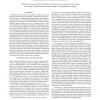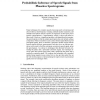51 search results - page 7 / 11 » On the Use of Time-Frequency Representation in Multicomponen... |
IJON
2008
13 years 7 months ago
2008
Discovering a representation that allows auditory data to be parsimoniously represented is useful for many machine learning and signal processing tasks. Such a representation can ...
ICASSP
2011
IEEE
12 years 11 months ago
2011
IEEE
A collaborative framework for detecting the different sources in mixed signals is presented in this paper. The approach is based on CHiLasso, a convex collaborative hierarchical s...
NIPS
2003
13 years 9 months ago
2003
Many techniques for complex speech processing such as denoising and deconvolution, time/frequency warping, multiple speaker separation, and multiple microphone analysis operate on...
ICA
2007
Springer
13 years 11 months ago
2007
Springer
Non-negative spectrogram factorization has been proposed for single-channel source separation tasks. These methods operate on the magnitude or power spectrogram of the input mixtur...
ICASSP
2011
IEEE
12 years 11 months ago
2011
IEEE
The Degenerate Unmixing Estimation Technique (DUET) is a Blind Source Separation (BSS) algorithm for stereo audio. DUET depends on an amplitude-phase 2d histogram built from the d...


